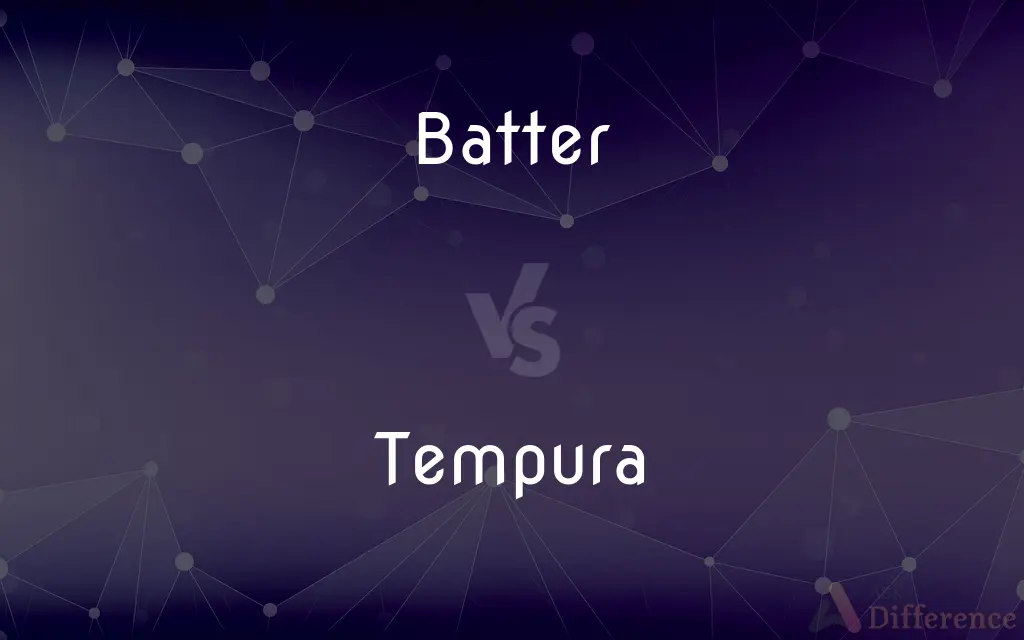Batter vs. Tempura — What's the Difference?
By Tayyaba Rehman & Fiza Rafique — Updated on April 8, 2024
Batter is a mixture of flour, liquid, and other ingredients used for coating or creating various dishes, while tempura is a specific type of light, airy batter from Japanese cuisine, used for frying seafood and vegetables.

Difference Between Batter and Tempura
Table of Contents
ADVERTISEMENT
Key Differences
Batter is a versatile mixture that can be thick or thin, used in both sweet and savory dishes, from pancakes to fried chicken. It often includes flour, eggs, and milk or water, but ingredients vary based on the recipe. Tempura, on the other hand, is a specific batter technique from Japan, characterized by its light, crisp texture, often made with cold water, flour, and sometimes egg, specifically for deep-frying.
While the primary purpose of batter is to add texture and flavor to food through methods like frying, baking, or pancake making, tempura aims to enhance the natural flavors of its ingredients, usually seafood and vegetables, by encasing them in a delicate, crispy coating. This highlights the contrast in their culinary roles and outcomes.
The composition of batter can include a variety of ingredients such as baking powder for leavening, beer for flavor and lightness, or even pureed vegetables for color and nutrition. Tempura batter, however, is traditionally made with minimal ingredients to maintain its characteristic lightness and is often kept cold to prevent gluten development, which keeps the batter crispy when fried.
Culturally, batter is used worldwide in countless recipes, reflecting local ingredients and tastes, from American corn dogs to British fish and chips. Tempura has its roots in Japanese cuisine but has gained international popularity, often served in Japanese restaurants worldwide and adapted into fusion cuisine.
The technique of preparing and using the batter differs as well; for example, some batters require resting to allow ingredients to hydrate and flavors to meld, while tempura batter is used immediately after mixing to preserve its airy texture when cooked.
ADVERTISEMENT
Comparison Chart
Ingredients
Flour, liquid (milk/water), eggs, possibly leavening agents
Cold water, flour, sometimes egg, minimal seasoning
Purpose
Coating, creating dishes (fried or baked)
Specifically for frying, creating a light, crispy coating
Texture
Can vary from light to dense
Light, airy, and crisp
Preparation Variability
Wide range, including resting time for some
Mixed gently and used immediately to avoid gluten formation
Culinary Use
Worldwide, in a variety of dishes
Primarily in Japanese cuisine for seafood and vegetables
Compare with Definitions
Batter
A versatile mixture for coating or making various dishes.
The chef dipped the fish in batter before frying it.
Tempura
A light, crispy batter from Japanese cuisine.
They served shrimp tempura as an appetizer.
Batter
Ingredients and thickness can vary.
For waffles, he prepared a thicker batter.
Tempura
Used for frying vegetables and seafood.
Vegetable tempura included sweet potatoes and bell peppers.
Batter
Can be sweet or savory.
She made a sweet batter for the dessert crepes.
Tempura
Represents a specific frying technique.
Making tempura requires a fast, hot fry to achieve its signature lightness.
Batter
Reflects diverse culinary practices.
For breakfast, they made a batter for pancakes.
Tempura
Made with cold water and flour for crispiness.
He mixed the tempura batter with ice-cold water.
Batter
Used in both frying and baking.
She poured the batter into the cake pan.
Tempura
Characterized by its airy texture.
The tempura batter created a delicate coating on the fish.
Batter
To hit heavily and repeatedly with violent blows.
Tempura
Tempura (天ぷら or 天麩羅, tenpura, [tempɯɾa]) is a typical Japanese dish usually consisting of seafood, meat, and vegetables that have been battered and deep fried. The dish was introduced by the Portuguese residing in Nagasaki through the fritter-cooking techniques in the 16th century.
Batter
To subject to repeated beatings or physical abuse.
Tempura
A Japanese dish of vegetables and shrimp or other seafood dipped in batter and fried in deep fat.
Batter
To damage, as by heavy wear
A shed battered by high winds.
Tempura
A Japanese dish made by deep-frying vegetables, seafood, or other foods in a light batter.
Batter
To attack verbally, as with criticism.
Tempura
Vegetables and seafood dipped in batter and deep-fried
Batter
To harass or distress, as with repeated questions.
Batter
To deliver repeated heavy blows; pound
Battered on the door with both fists.
Batter
To coat in batter
Battered the vegetables and then fried them.
Batter
To construct so as to create an upwardly receding slope.
Batter
A damaged area on the face of type or on a plate.
Batter
The player at bat in baseball and cricket.
Batter
A liquid or semiliquid mixture, as of flour, milk, and eggs, used in cooking.
Batter
A slope, as of the outer face of a wall, that recedes from bottom to top.
Batter
To hit or strike violently and repeatedly.
The firemen battered down the door.
Batter
(cooking) To coat with batter (the food ingredient).
I prefer it when they batter the cod with breadcrumbs.
Batter
(figurative) To defeat soundly; to thrash.
Leeds United battered Charlton 7-0.
Batter
To intoxicate.
That cocktails will batter you!
I was battered last night on our pub crawl.
Batter
(metalworking) To flatten (metal) by hammering, so as to compress it inwardly and spread it outwardly.
Batter
(architecture) To slope (of walls, buildings etc.).
Batter
A beaten mixture of flour and liquid (usually egg and milk), used for baking (e.g. pancakes, cake, or Yorkshire pudding) or to coat food (e.g. fish) prior to frying.
Pancake batter
To the dismay of his mother, the boy put his finger into the cake batter.
Batter
A binge; a heavy drinking session.
When he went on a batter, he became very violent.
Batter
A paste of clay or loam.
Batter
A bruise on the face of a plate or of type in the form.
Batter
An incline on the outer face of a built wall.
Batter
(baseball) The player attempting to hit the ball with a bat.
The first batter hit the ball into the corner for a double.
Batter
(cricket) A player of the batting side now on the field.
Batter
(cricket) The player now receiving strike; the striker.
Batter
(cricket) Any player selected for his or her team principally to bat, as opposed to a bowler.
Batter
To beat with successive blows; to beat repeatedly and with violence, so as to bruise, shatter, or demolish; as, to batter a wall or rampart.
Batter
To wear or impair as if by beating or by hard usage.
Batter
To flatten (metal) by hammering, so as to compress it inwardly and spread it outwardly.
Batter
To slope gently backward.
Batter
A semi-liquid mixture of several ingredients, as, flour, eggs, milk, etc., beaten together and used in cookery.
Batter
Paste of clay or loam.
Batter
A bruise on the face of a plate or of type in the form.
Batter
A backward slope in the face of a wall or of a bank; receding slope.
Batter
The one who wields the bat in baseball; the one whose turn it is at bat; formerly called the batsman.
Batter
(baseball) a ballplayer who is batting
Batter
A flour mixture thin enough to pour or drop from a spoon
Batter
Strike against forcefully;
Winds buffeted the tent
Batter
Strike violently and repeatedly;
She clobbered the man who tried to attack her
Batter
Make a dent or impression in;
Dinge a soft hat
Common Curiosities
Can batter include flavors or colors?
Yes, batters can be flavored or colored with various ingredients like herbs, spices, or pureed vegetables, depending on the desired outcome.
Why is cold water important in tempura batter?
Cold water inhibits gluten formation, ensuring the batter remains light and crispy when fried.
Is there a difference in the frying technique for batter and tempura?
Yes, while both are deep-fried, tempura is fried quickly in hot oil to maintain its light texture, whereas other batters might be cooked differently based on the recipe.
Can batter be made ahead of time?
Some batters can be made ahead and stored, but tempura batter should be made right before use to keep its crispiness.
Can tempura batter be used for non-Japanese dishes?
Yes, tempura batter is versatile and can be used to fry a variety of foods beyond traditional Japanese ingredients.
How does the thickness of the batter affect the final dish?
A thicker batter creates a denser coating, while a thinner batter provides a lighter, crispier texture.
Why do some batters include beer?
Beer is sometimes added to batter for flavor and because the carbonation makes the batter lighter and crispier.
What makes tempura batter different from other batters?
Tempura batter is distinguished by its light, airy texture and minimal ingredients, designed to enhance the natural flavors of the fried food.
Can any type of flour be used for tempura?
While all-purpose flour is common, specialized tempura flour is also available, which may include additives to enhance the lightness and crispiness of the batter.
How do you know when tempura is done cooking?
Tempura is done when the coating is light golden and crispy, typically after a few minutes of frying.
What are common ingredients dipped in tempura batter?
Seafood, like shrimp and squid, and vegetables, such as bell peppers, sweet potatoes, and mushrooms, are common.
Are there gluten-free options for batter and tempura?
Yes, there are gluten-free flours available that can be used to make both batter and tempura suitable for those avoiding gluten.
What's the key to a crispy batter?
Factors include the batter's consistency, the temperature of the liquid, and the frying oil's temperature.
Is batter only used for frying?
No, batter can also be used for baking, such as in cakes and muffins, in addition to frying.
Can you re-use tempura batter?
Tempura batter is best used fresh and is not typically reused after it has been mixed.
Share Your Discovery

Previous Comparison
Hernia vs. RuptureNext Comparison
Semiconductor vs. SemimetalAuthor Spotlight
Written by
Tayyaba RehmanTayyaba Rehman is a distinguished writer, currently serving as a primary contributor to askdifference.com. As a researcher in semantics and etymology, Tayyaba's passion for the complexity of languages and their distinctions has found a perfect home on the platform. Tayyaba delves into the intricacies of language, distinguishing between commonly confused words and phrases, thereby providing clarity for readers worldwide.
Co-written by
Fiza RafiqueFiza Rafique is a skilled content writer at AskDifference.com, where she meticulously refines and enhances written pieces. Drawing from her vast editorial expertise, Fiza ensures clarity, accuracy, and precision in every article. Passionate about language, she continually seeks to elevate the quality of content for readers worldwide.














































